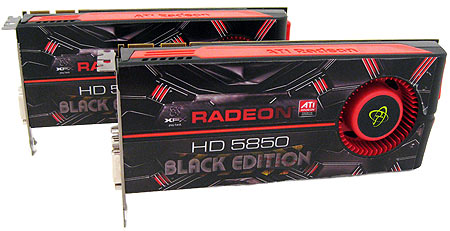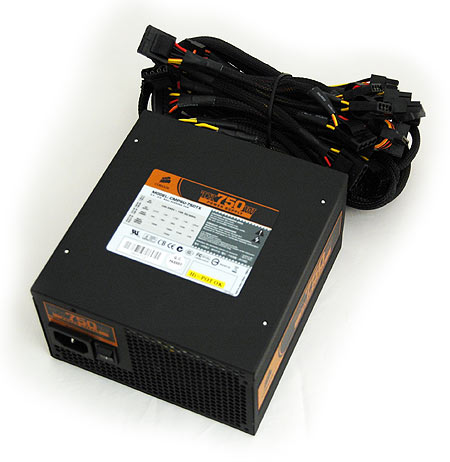System Builder Marathon, Dec. 2009: $1,300 Enthusiast PC
Video Cards And Power Supply
Video Cards: 2 x Radeon HD 5850 in CrossFire
The Radeon HD 5850 outperforms the GeForce GTX 285 at a lower cost, and we were looking forward to putting two of these cards in a CrossFire configuration to give our $1,300 system some hard-hitting graphics prowess.
Radeon HD 5850 cards were somewhat hard to come by in the weeks following their introduction, but it finally looks like there is a steady enough supply now. Unfortunately, organizing a System Builder Marathon (SBM) takes weeks to prepare and Radeon HD 5850s were still scarce when we ordered the parts.
While we wanted the cards that offered the best price/performance ratio--some Radeon HD 5850s can be bought for as low as $310--these low-priced specimens were not available when we ordered, so we were forced to take what we could get. We got our hands on two XFX HD-585A-ZNBC Radeon HD 5850 Black Edition cards (thanks, XFX!), which are factory overclocked models that cost about $50 more than a garden-variety Radeon HD 5850. The good news for whoever win's this month's $1,300 system is that you'll get a couple of super-charged graphics cards.
Read Customer Reviews of XFX's HD-585A-ZNFC
With Radeon HD 5850s now available for purchase at $310, here's what we've done: we've budgeted for the cheaper version of Radeon HD 5850s and underclocked our Radeon HD 5850 Black Edition cards to reference 725 MHz core/1,000 MHz memory speeds for our stock results. For our overclocked results, we pushed the cards to the maximum allowed in the BIOS, which happens to be 10 MHz core speed faster than the factory clock of the Radeon HD 5850 Black Edition at 765 MHz core/1,250 MHz memory. The overclocked results will give a clear indication of what the XFX card can do out of the box.
I will point out that it was very late in the game when we learned that the new 1.4 version of MSI's Afterburner overclocking utility has the ability to bypass the graphics card's imposed overclocking limits simply by selecting "Enable Unofficial Overclocking value to 1" option in the program's MSIAfterburner.cfg file. Overclocking results can likely be pushed much higher with voltage increases, so this is something to keep in mind for you overclockers out there. These cards will have a lot more potential for higher clocks than we achieved here if voltages are pushed and the BIOS limit is breached.
Get Tom's Hardware's best news and in-depth reviews, straight to your inbox.
Power Supply: Corsair CMPSU-750TX
Read Customer Reviews of Corsair's CMPSU-750TX
On sale for $110 with an additional $20 rebate, the Corsair CMPSU-750TX is a no-brainer for high performance and value. A single mammoth 60 amp rail will supply all the graphics power we'll ever need without complaint, and the 80 PLUS efficiency rating is very much appreciated.
Current page: Video Cards And Power Supply
Prev Page CPU, Motherboard, And Case Next Page Memory, Hard Drive, And Optical DriveDon Woligroski was a former senior hardware editor for Tom's Hardware. He has covered a wide range of PC hardware topics, including CPUs, GPUs, system building, and emerging technologies.
-
Crashman Great build Don! The only thing I'd change is to use the RAM from the $2500 system! It's too bad you didn't have enough money left over to buy a big cooler.Reply -
noob2222 Very smoothe build, pretty limited with the 5850s with the pricing once past that, but this thing handles it well, esp since the cpu was lucky enough to stay fast while undervolted.Reply
Not all cpus are the same, this one compared to the $2500 build definatly shows it. Takes a bit of luck sometimes or bad luck. -
Tridec Just a thought, but why not use an I7 920 CPU, with an asrock x58 Extreme motherboard? I see a lot of people bought their I7 920 CPU for 199 dollars and the motherboard costs 170 dollars.Reply
Pair that up with OCZ 1333 platinum 7-7-7-24 memory, that can easily be overclocked to 1600 7-7-7-24 and you'll have a powerful system with 36 PCI-e lanes and loads of CPU overclocking room thanks to asrock's great motherboard. -
SpadeM Good article, and yes the quadfire setup was sweet back then!! I just have a question/suggestion to make, and if you find worthy of a replay I'd much appreciate it.Reply
Since you are willing to experiment with different setups, and since we see the problem with the Phenom in the application suite, why not try something more exotic like pairing a nvidia based card with the crossfire cards to act like a PPU / video transcoding accelerator (TMPEng supports CUDA at least to act as a filter). I don't know if this makes sense in a marathon build, but I'd like to see something like this benchmarked.
-
shubham1401 This is an excellent build.Reply
With an aftermarket cooler this build will be flawless.
Power Draw,Performance all were nice.
The case looks nice too. -
burnley14 I'm not especially interested in the gaming results per se, but this build certainly solidifies my choice to go with an Intel processor over AMD based on productivity benchmarks.Reply -
optional22 Aside from the video cards, this is essentially the same build as the $2,500 build recently posted performance-wise. What is the point?Reply -
kick_pixels Good system over all… an extra hard drive for backup is essential and the wiring needs some tiding up.Reply
-
cangelini More specifically, these guys are trying different things each time we do a round of SBMs--sometimes the results are great, and sometimes they're not as good. The point is that we're putting the machines together and reporting on the results so that you can decide if you want to do the same or not. And hopefully, when we come across a result that doesn't look so hot, we'll call out where our mistake was in building the box.Reply
Just think how boring these would be if every quarter we did a Core i7-920-based machine at $2,500, a Core i5-750 machine at $1,500, and a Phenom II-based box at $700! =)




